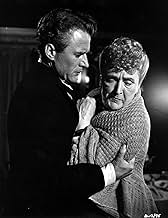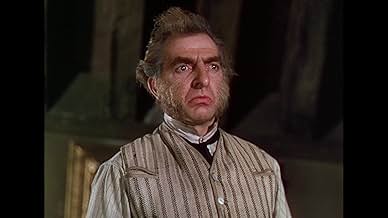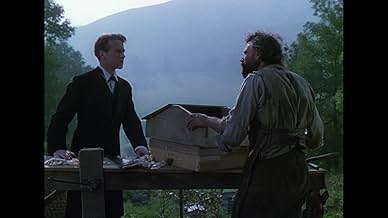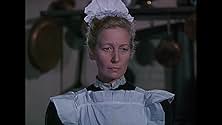IMDb RATING
6.9/10
1.6K
YOUR RATING
A beautiful, superstitious, animal-loving Gypsy is hotly desired by a fox-hunting squire even after she marries a clergyman.A beautiful, superstitious, animal-loving Gypsy is hotly desired by a fox-hunting squire even after she marries a clergyman.A beautiful, superstitious, animal-loving Gypsy is hotly desired by a fox-hunting squire even after she marries a clergyman.
- Directors
- Writers
- Stars
- Awards
- 3 wins & 1 nomination total
Arthur Mainzer
- Chapel elder
- (as Arthur Reynolds)
- Directors
- Writers
- All cast & crew
- Production, box office & more at IMDbPro
Featured reviews
Somehow this film was made without the incessant tinkering for which David O. Selznick was notoriously famous, presumably because he had allowed his wife, Jennifer Jones, to travel to Great Britain and work her magic untrammelled by his day-to-day presence on the set and in the screening room as rushes were viewed. By all reports, however, he was so horrified by what Powell and Pressburger had wrought that what we on this side of the Atlantic were allowed to view bears only a faint resemblance to the intentions of those English artists,
It has been years since I saw, on a television broadcast, a no doubt truncated and heavily reedited version under its U.S. title, "The Wild Heart" but, as I had before, I was amazed at the "Archers" beautiful, almost florid, use of Technicolor and their apparently reckless disregard for the expectations of an audience weaned on American pablum and the more refined output of their English peers of the cinema.
Miss Jones is vibrantly beautiful and endlessly fascinating as she plays Hazel Woodus and it goes without saying that her support from a memorable cast of carefully chosen players, professional and, I would guess, amateur is of an order that one can always confidently expect from the British both on stage and on screen. It's wishful thinking, at this late date, I suppose but a VHS or DVD version, available to us here in the U.S., would be a remarkable addition to a movie-lover's library.
It has been years since I saw, on a television broadcast, a no doubt truncated and heavily reedited version under its U.S. title, "The Wild Heart" but, as I had before, I was amazed at the "Archers" beautiful, almost florid, use of Technicolor and their apparently reckless disregard for the expectations of an audience weaned on American pablum and the more refined output of their English peers of the cinema.
Miss Jones is vibrantly beautiful and endlessly fascinating as she plays Hazel Woodus and it goes without saying that her support from a memorable cast of carefully chosen players, professional and, I would guess, amateur is of an order that one can always confidently expect from the British both on stage and on screen. It's wishful thinking, at this late date, I suppose but a VHS or DVD version, available to us here in the U.S., would be a remarkable addition to a movie-lover's library.
A beautifully made and gently rolling film, almost surreal in content.
Some moments almost seem off cue and through a breathtakingly simple narrative visual style, comes a story of innocence, passion and ultimate tragedy. The music is hypnotic and compliments the flow of the film.
Superb performance by all - including 'Foxy'! If this film was made today it would be showered with Oscars.
Finally, it is hard to see a comparable style in the British film industry prior to this and certainly nothing after it. It is this fact that I believe contributes to the films unique qualities.
Some moments almost seem off cue and through a breathtakingly simple narrative visual style, comes a story of innocence, passion and ultimate tragedy. The music is hypnotic and compliments the flow of the film.
Superb performance by all - including 'Foxy'! If this film was made today it would be showered with Oscars.
Finally, it is hard to see a comparable style in the British film industry prior to this and certainly nothing after it. It is this fact that I believe contributes to the films unique qualities.
about a wild child in rural England in 1897. Half gypsy, the girl (Jennifer Jones) worships nature, animals, superstitions, etc. but has an odd, eerie "one-ness" with the world. However, when sex enters the picture, her world spins out of control. A timid parson (Cyril Cusack) marries her but chains her to a sexless marriage. She runs off with a lusty squire (David Farrar) and lives in his ramshackle estate. Truly offbeat story, totally gorgeous cinematography by Christopher Challes, and good performances by all make this watchable. Sadly, the US version had 30 minutes lopped off and shows it. The Brit version, titled "Come to Earth" is supposedly superior. Symbolism is worthy of any good Lawrencian story where love is in opposition to nature and where sex can only survive outside marriage. Jones looks great. Oddly forgotten now, she was not your average leading lady, and like Meryl Streep or Glenn Close or Bette Davis, chose to play all sorts of "character" parts rather than be confined by Hollywood. Worthy of the Emeric Pressburger/Michael Powell canon; this might be a great film!
I saw this glorious film when it first appeared. The following week I tracked it down to a small London cinema where they screened single films continuously several times a day without supporting features. I hadn't intended seeing it more than once on this occasion but I can recall being so mesmerised that I watched the programme through three times. Clearly I was out of step with the climate of critical opinion. The reviewers had slated it and the audience around me was distinctly hostile. There was a lot of fidgeting and derisory shouts. Quite a few walked out. Behaviour was often bad in British cinemas in the 'fifties particularly if viewers got bored. The manager called the police in during a screening I attended a few years later of "The Trouble WIth Harry" and I can even remember screaming at the usherettes to stop talking when I first saw "A Face in the Crowd". I had to wait many years before I heard good things being said about "Gone to Earth". It was in 1988 when someone introduced a showing of it on British television most enthusiastically. Whatever one thinks about the relative merits of Powell and Pressburger's films (I am clearly in a minority in thinking this their finest) there is no doubt that they are now appreciated in a way they never were when they first appeared. But if passion for what is still considered one of their minor works may seem rather over the top, let me say but one thing; where else in the whole of cinema is there a more haunting and magical evocation of English landscape! Christopher Challis, a brilliant cinematographer, is the real star of the film. Undoubtedly (and this is perhaps at the core of its original problems) style matters more than content. The plot is little more than Victorian melodrama - lecherous squire deflowers simple country girl who has married local vicar - and the dialogue is curiously stilted. However this hardly matters in a work cinematically choreographed with such brilliance. The final foxhunting sequence, where the film's many strands are brought together, is visually and aurally one of the most spellbinding in all cinema. The huntsman's cry of "Gone to earth!" at the very end has haunted me for well over half a lifetime.
This was a hard film to see for a very long time, at least in any form that would do it justice. But the small snippets of it I'd caught made me steadfastly wait for the day I could view it, and having done so, I can say it's considerably better than its fairly middling reputation.
Maybe the easiest way to describe it is as Powell & Pressburger's "Wuthering Heights" - it's set in that gothic period drama genre, anyway - but at root it's a grown-up, thoughtful and adult romance-of-sorts set on windswept fairy-tale moors.
The two films it fits closest to in their body of work would be "I Know Where I'm Going" (for the elemental setting) and especially Black Narcissus, for the matchless colour photography and mood of suppressed eroticism bubbling savagely beneath the surface. You can feel the invisible forces of superstition and desire affecting events, the tiny figures swamped by a greater Nature beyond their understanding or powers.
As I've already said, this is a grown-up film, a good 15 years or more before its time in its depiction of adultery and complexity of emotion in a potboiler setting. The sexuality in it is not explicit, but it's firmly engraved in stone between the lines of the script and in small moments of quiet force - flickers of understanding, judgement or confusion passing over every face throughout, speaking volumes.
There's a lurid, hyperreal, almost cartoonishly painterly look to the colour films of the 40s and 50s, which was never seen again afterwards, and is now impossible to recreate. This one has the texture of Singin' In The Rain but is, unusually, set largely outdoors, in the real world, in wide open spaces. Because of this, the nature scenes look, gorgeously, straight out of Bambi.
Gone To Earth is not P&P's greatest film, but it's a real treasure nonetheless. A wild, dark, pagan beauty.
Maybe the easiest way to describe it is as Powell & Pressburger's "Wuthering Heights" - it's set in that gothic period drama genre, anyway - but at root it's a grown-up, thoughtful and adult romance-of-sorts set on windswept fairy-tale moors.
The two films it fits closest to in their body of work would be "I Know Where I'm Going" (for the elemental setting) and especially Black Narcissus, for the matchless colour photography and mood of suppressed eroticism bubbling savagely beneath the surface. You can feel the invisible forces of superstition and desire affecting events, the tiny figures swamped by a greater Nature beyond their understanding or powers.
As I've already said, this is a grown-up film, a good 15 years or more before its time in its depiction of adultery and complexity of emotion in a potboiler setting. The sexuality in it is not explicit, but it's firmly engraved in stone between the lines of the script and in small moments of quiet force - flickers of understanding, judgement or confusion passing over every face throughout, speaking volumes.
There's a lurid, hyperreal, almost cartoonishly painterly look to the colour films of the 40s and 50s, which was never seen again afterwards, and is now impossible to recreate. This one has the texture of Singin' In The Rain but is, unusually, set largely outdoors, in the real world, in wide open spaces. Because of this, the nature scenes look, gorgeously, straight out of Bambi.
Gone To Earth is not P&P's greatest film, but it's a real treasure nonetheless. A wild, dark, pagan beauty.
Did you know
- TriviaThe choir was the real choir from the local Methodist chapel. When he heard them singing, director Michael Powell said they were too good and he wanted them to sound "more ragged, like a choir of country folk" only to be told "But we ARE country folk, Mr. Powell."
- GoofsAs Abel and Hazel Woodus come down the hill to the chapel, the mine engine house disappears and then reappears between shots
- Quotes
Hazel Woodus: The world wasn't made in seven days only for Abel Woodus.
- Alternate versionsThe reedited and shortened version titled "The Wild Heart" was produced after a disagreement and court case between director Michael Powell and producer David O. Selznick. Selznick's changes are mainly:- (1) Adding a prologue. (2) Adding scenes explaining things, often by putting labels or inscriptions on them. (3) Adding more close-ups of Jennifer Jones (Selznick's wife). He also deleted a few scenes that he felt weren't dramatic enough. Sadly some of these were major plot points so the story doesn't make as much sense as the original. In his autobiographies, Powell claimed that Selznick only left about 35 mins of the original film. In fact there's a lot more than that. About 2/3 of the original remains.
- ConnectionsFeatured in The Late Show: Michael Powell (1992)
- How long is Gone to Earth?Powered by Alexa
Details
- Runtime1 hour 50 minutes
- Color
- Aspect ratio
- 1.37 : 1
Contribute to this page
Suggest an edit or add missing content































